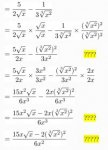Thanks for the suggestions.
So I guess if I can rationalise the second fraction, I can find a common factor of both denominators and then subtract the fractions.
But I don't have a strong intuitive sense of what a cube root of a square number is, so I'm struggling to figure out what version of '1' to multiply the second fraction by to rationalise its denominator.
I get that the cube root of x squared can be rewritten as x to the power of 2 thirds. And I think what this means is basically the number that when multiplied by itself three times will be equal to x squared?
Does that mean I need to multiply the denominator by (the cube root of x squared) squared, to end up with 3x^2 as the denominator, etc? If I carry on like this, I get a common denominator of 6x^2, and a big ugly numerator. See attached pic. Does it look right? Is this a better way of writing it than what I started with? Can the brackets in the second half of the numerator be expanded?
View attachment 9994
First, you were going strong there.
Yes, \(\displaystyle \sqrt[3]{x^2} * \sqrt[3]{x^2} * \sqrt[3]{x^2} = (\sqrt[3]{x^2})^2 = x^2.\)
So to get rid of that cube root of x squared, you need to multiply by the square of the cube of x^2. (This is quicker to perceive using fractional exponents.)
\(\displaystyle \dfrac{5\sqrt{x}}{2x} - \dfrac{1}{3\sqrt[3]{x^2}} = \dfrac{5\sqrt{x}}{2x} - \left ( \dfrac{1}{3\sqrt[3]{x^2}} * 1 \right) = \dfrac{5\sqrt{x}}{2x} - \dfrac{1}{3\sqrt[3]{x^2}} * \left ( \dfrac{\sqrt[3]{x^2}}{\sqrt[3]{x^2}} \right )^2 = \dfrac{5\sqrt{x}}{2x} - \dfrac{(\sqrt[3]{x^2})^2}{3x^2}.\)
Now lets consider simplifying the numerator of the second fraction.
\(\displaystyle (\sqrt[3]{x^2})^2 = \sqrt[3]{x^2} * \sqrt[3]{x^2} = \sqrt[3]{x^2 * x^2} =\)
\(\displaystyle \sqrt[3]{x^4} = \sqrt[3]{x^3 * x} = x\sqrt[3]{x}.\)
\(\displaystyle \therefore \dfrac{5\sqrt{x}}{2x} - \dfrac{(\sqrt[3]{x^2})^2}{3x^2} = \dfrac{5\sqrt{x}}{2x} - \dfrac{x\sqrt[3]{x}}{3x^2} = \dfrac{5\sqrt{x}}{2x} - \dfrac{\sqrt[3]{x}}{3x}.\)
When you work with radicals, remember to simplify them as well.
And now the common denominator work is really easy.
\(\displaystyle \dfrac{5\sqrt{x}}{2x} - \dfrac{\sqrt[3]{x}}{3x} = \dfrac{5\sqrt{x}}{2x} * \dfrac{3}{3} - \dfrac{\sqrt[3]{x}}{3x} * \dfrac{2}{2} = \dfrac{15\sqrt{x} - 2\sqrt[3]{x}}{6x}.\)
Notice that the process of getting common denominators also involves multiplying by 1 in a convenient form.
Now check your work. 64 is a convenient number to work with because it is the smallest number greater than 1 that is both a perfect square and a perfect cube. (Never check a simplification with 0 or 1.)
\(\displaystyle \dfrac{5}{2\sqrt{64}} - \dfrac{1}{3\sqrt[3]{64^2}} = \dfrac{5}{2 * 8} - \dfrac{1}{3 * 16} = \dfrac{5}{16} - \dfrac{1}{48} = \dfrac{15 - 1}{48} = \dfrac{14}{48} = \dfrac{7}{24}.\)
\(\displaystyle \dfrac{15\sqrt{64} - 2\sqrt[3]{64}}{6 * 64} = \dfrac{15 * 8 - 2 * 4}{6 * 64} =\dfrac{8(15 - 1)}{6 * 64} = \dfrac{14}{6 * 8} = \dfrac{7}{24}.\)
So it checks.
Now as others have said, you can do this more quickly using fractional exponents so I'd make sure to become comfortable with them.





